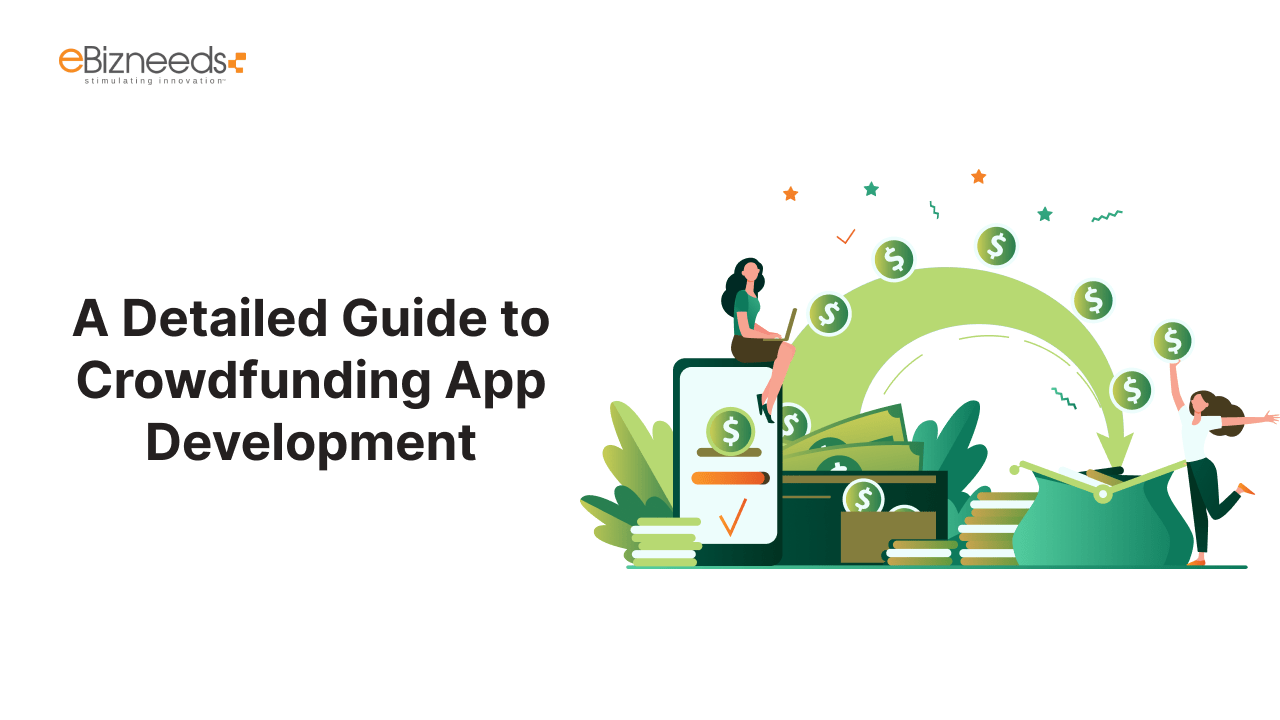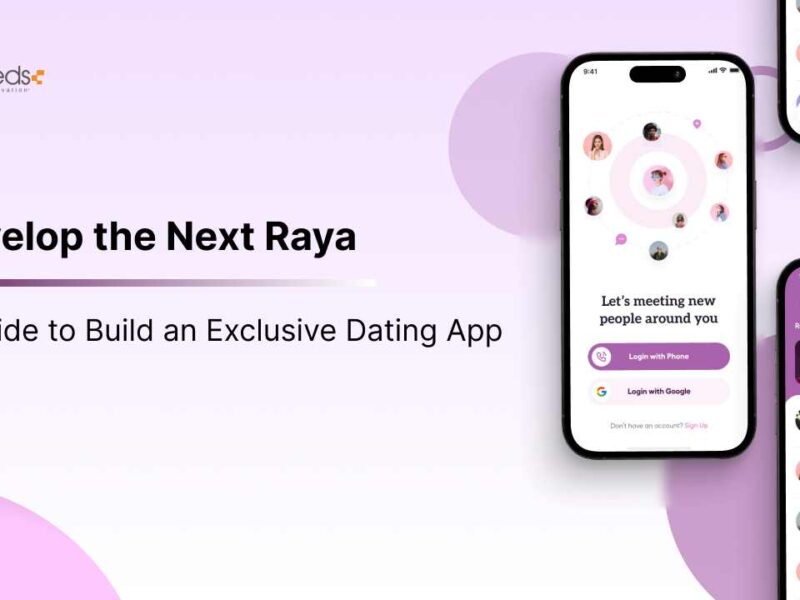Whether it is a startup or a small business, everyone looks out for every possible avenue to grow and expand their business.
One such way is crowdfunding. The demand for crowdfunding apps has seen exponential growth in the last few years.
Needless to say, there are a lot of people who want to build a crowdfunding app.
With a crowdfunding app, businesses or startups can showcase their ideas to potential backers and raise money.
In exchange for funds, the investors might get various items depending upon the type of crowdfunding. That’s why there are many people who are looking for crowdfunding app development services from experts.
The aim of crowdfunding apps is to simplify the process and make it easier for businesses and investors to connect and align with the same vision.
In this blog, we will go through all the major aspects of creating a crowdfunding app, including its benefits, development process, major features, and more.
Let’s begin with the basics.
What is a Crowdfunding App?
Crowdfunding is a process that allows anyone to raise an amount through small donations from multiple resources belonging to various areas.
There are a lot of people who fund a project, and there is very little donation from a single resource in this process. However, a good crowdfunding app aims to increase donations by adding multiple donors.
The main factors for the growth of crowdfunding are charity and contributions.
There are multiple marketing strategies which drive the contributors’ and donors’ decisions. If the startups are focusing on social causes then they also influence the crowd to support them through donations.
Crowding funding apps play a pivotal role in facilitating the process of raising funds from investors.
These apps are digital platforms that connect stakeholders like individuals, organizations, and businesses to create fundraising campaigns and reach out to potential donors or investors.
Basically, they are acting like intermediaries with multiple responsibilities.
A crowdfunding app connects project creators with individuals who have an interest in those projects. It acts as a convenient and accessible way for people to contribute financially in projects, entrepreneurial ventures, charitable endeavours, medical expenses, etc.
With this being out of the way, it’s time to see why make a crowdfunding app in 2024.
Why invest in Crowdfunding App Development? Market Overview:
Before making any investment, it is crucial to know its market potential.
The market statistics of the crowdfunding industry will help why you must invest in crowdfunding mobile app development.
Here are the major facts and figures to help you make better decisions to create a crowdfunding app:
By 2024, the transactional value in the crowdfunding market is expected to reach $1.2 billion.
It is growing at a Compound Annual Growth Rate (CAGR) of 1.43% from 2024 to 2028.
The average funding per campaign in the Crowdfunding market amounts to $8.15k in 2024.
Now that you have some reasons to create a crowdfunding platform, it’s time to discuss the different types that you can make. Let’s see what these are:
Types of Crowdfunding Apps:
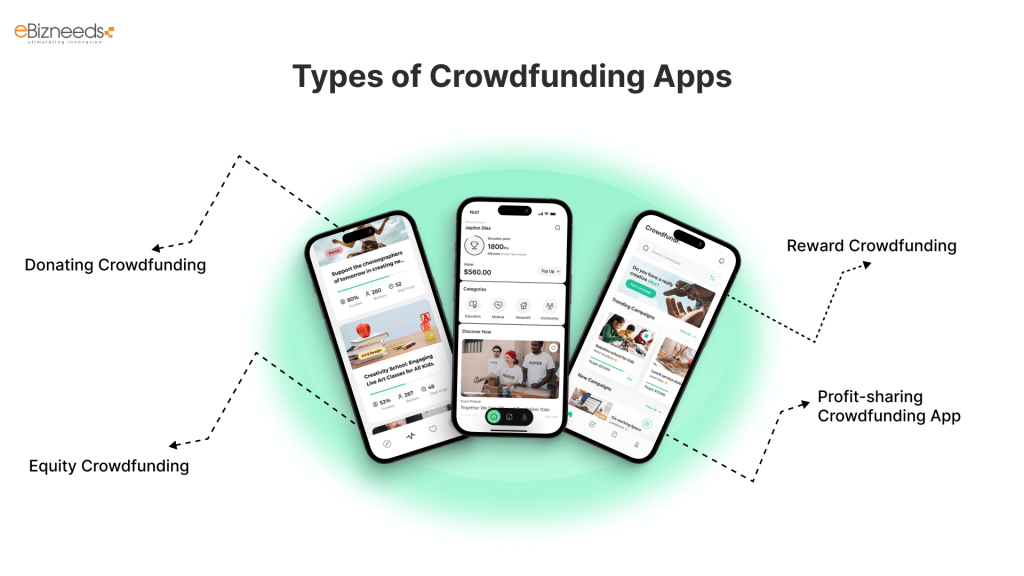


Before going for crowdfunding app development process, you should know what types of crowdfunding apps exist in the market.
By knowing the different types, you will get to know which app type would be suitable for your target audience.
Each crowdfunding app has a specific purpose. Here we have mentioned the major forms of crowdfunding apps:
a. Donating Crowdfunding
There is no explanation required for the donation term. The donation-based crowdfunding app aims to support a social or personal cause.
Here the contributors provide support to various businesses, persons, or campaigns and receive no return for this contribution. These types of crowdfunding apps are focused on charity projects.
Different contributors donate small or big amounts to meet the larger fund.
b. Equity Crowdfunding
In the equity crowdfunding apps, businesses aim to register capital online from investors.
Many different industries promote the growth of multiple startups. The equity crowdfunding apps help businesses attract investors and seek funding.
Unlike, donating crowdfunding, here the investors get equity ownership for that particular business.
These business crowdfunding apps offer multiple opportunities for investors and companies to grow businesses.
d. Reward Crowdfunding
The reward-based crowdfunding app is another type of crowdfunding platform development.
Here the contributors donate the money but unlike donating crowdfunding apps, they expect non-monetary rewards. These rewards commonly include goods and services, t-shirts, and many others.
The type of reward depends on the size of funding the supporters make for the campaigns.
e. Profit-sharing Crowdfunding App
The profit-sharing crowdfunding app provides high utility for both fundraising entrepreneurs and contributors.
In this type of crowdfunding apps, the investors expect to earn profits from the business.
The entrepreneur is responsible for utilizing the raised funds to achieve profits from the business activities and share the profits with the investors.
How Crowdfunding Apps Works?
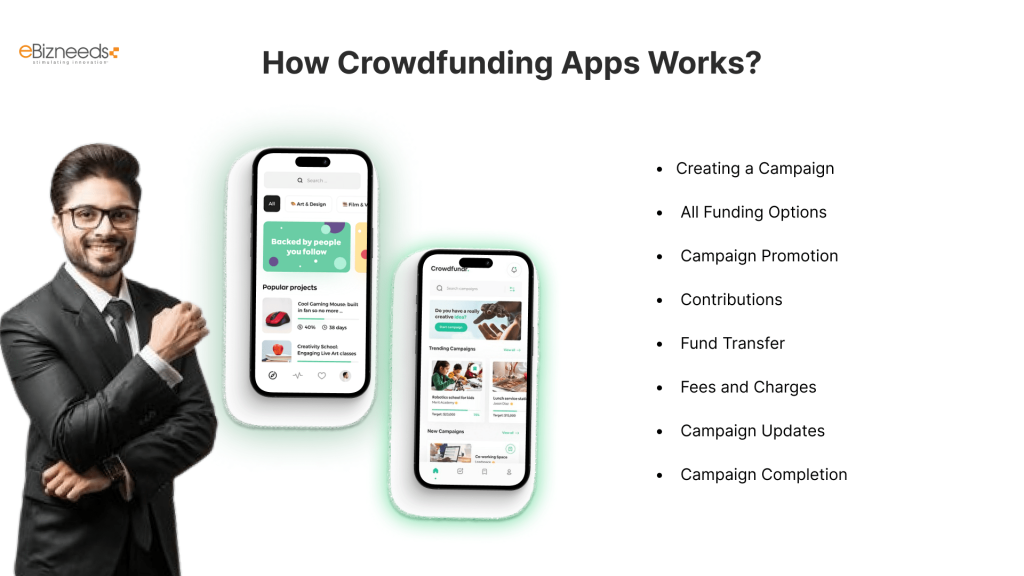


Another important thing to understand before creating a crowdfunding app is, how do they work?
Let’s look at just that below:
a. Creating a Campaign
In the crowdfunding app, the creators have to firstly register themselves. After registration, they can create a campaign on the app.
The creator has to provide several details of the campaign like purpose, goals, timeline, and funding target for creating the campaign.
To showcase the project effectively they can also add media elements like images or videos.
b. All Funding Options
During campaign creation, the creator also has to make a choice between fixed or flexible funding.
Now these are two major different funding types.
In the fixed funding, there is a fixed timeframe in which the creator has to accumulate the specified funding for the project, or else the funds will be returned to investors.
On the other side, in flexible funding, the creator can gather any amount or number of funds, doesn’t matter if the funding goals have been met or not.
c. Campaign Promotion
After filling in all the campaign entries, the campaign will go live.
Once it goes live, it is the responsibility of the creator to popularize it through social media channels, emails, or other mediums to reach a wider audience.
They motivate their kith and kin to contribute to their campaign and share it with others.
d. Contributions
Once it gets popularized, the users who will get to know about campaigns will check its details and decide if they want to invest or support it.
There is a secure payment processing system in the crowdfunding app in which users can make donations through various payment methods.
e. Fund Transfer
After a contribution is made by the user, the crowdfunding app securely processes the payment and holds the funds until the campaign ends.
In some cases, the funds are transferred immediately while in other cases, they are in hold until the campaign is successfully completed.
f. Fees and Charges
The crowdfunding app will either charge a fee or some percentage commission from the funds raised by the campaign creator.
The fees structure and percentage will depend on the app type and its policies.
g. Campaign Updates
It is the responsibility of the creator to provide regular updates to the donors, investors, or contributors.
The updates could be of progress, milestones achieved, and any relevant news.
It will help in keeping the contributors engaged and informed about the project’s development.
h. Campaign Completion
After the campaign is complete, the crowdfunding app transfers the funds raised (minus any fees or charges) to the campaign creator’s designated account.
In fixed funding campaigns, if the funding goal is not met, the app refunds the contributors to the donors.
Now that we are done with the working flow of
Top Crowdfunding Platforms to Learn from
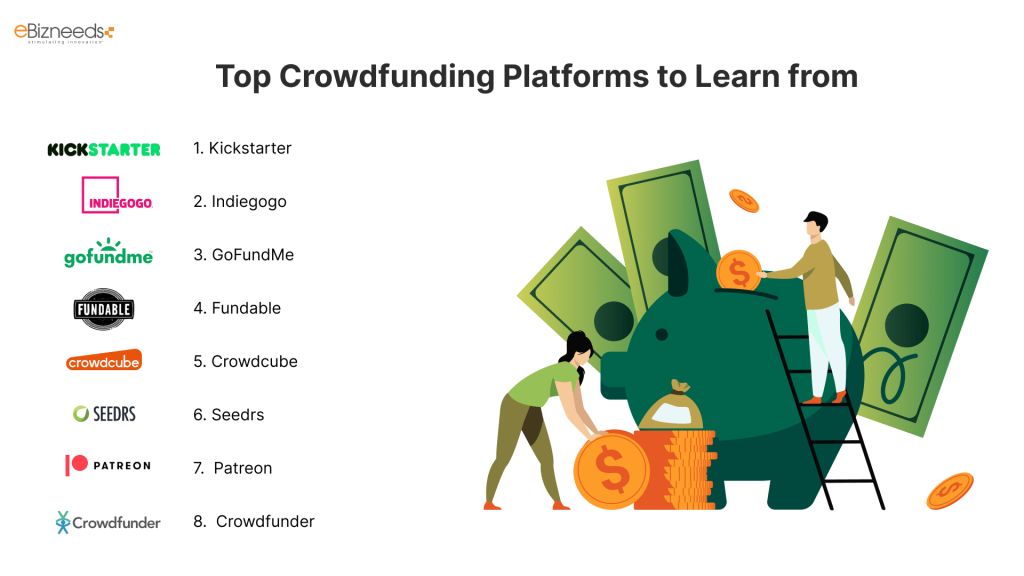


Exploring successful crowdfunding platforms can provide valuable insights for developing your own crowdfunding app.
Here are notable platforms to consider:
Kickstarter
A leading platform for creative projects, Kickstarter has facilitated over 225,000 successfully funded campaigns, making it a benchmark in the industry.
Indiegogo
Known for its flexibility, Indiegogo supports a wide range of projects, from tech innovations to community initiatives, offering both fixed and flexible funding options.
GoFundMe
Specializing in personal and charitable causes, GoFundMe has raised over $30 billion since its inception, highlighting the platform’s extensive reach and impact.
Fundable
Focused on startups, Fundable allows businesses to raise capital through rewards or equity-based campaigns, catering specifically to entrepreneurial ventures.
Crowdcube
A UK-based equity crowdfunding platform, Crowdcube enables investors to fund startups and growing businesses in exchange for equity, fostering a community of engaged backers.
Seedrs
Also based in the UK, Seedrs offers equity crowdfunding, allowing investors to buy shares in startups and later-stage businesses, supporting a diverse range of industries.
Patreon
Designed for creators, Patreon provides a subscription-based model where fans support artists, podcasters, and other creatives through recurring contributions, ensuring a steady income stream.
Crowdfunder
A UK-based platform, Crowdfunder supports community projects, startups, and social enterprises, offering both rewards and equity-based funding options to suit various campaign needs.
By analyzing these platforms, you can identify key features and strategies to incorporate into your own crowdfunding app development process, ensuring a user-friendly and effective platform for your target audience.
Essential Features of a Crowdfunding App:
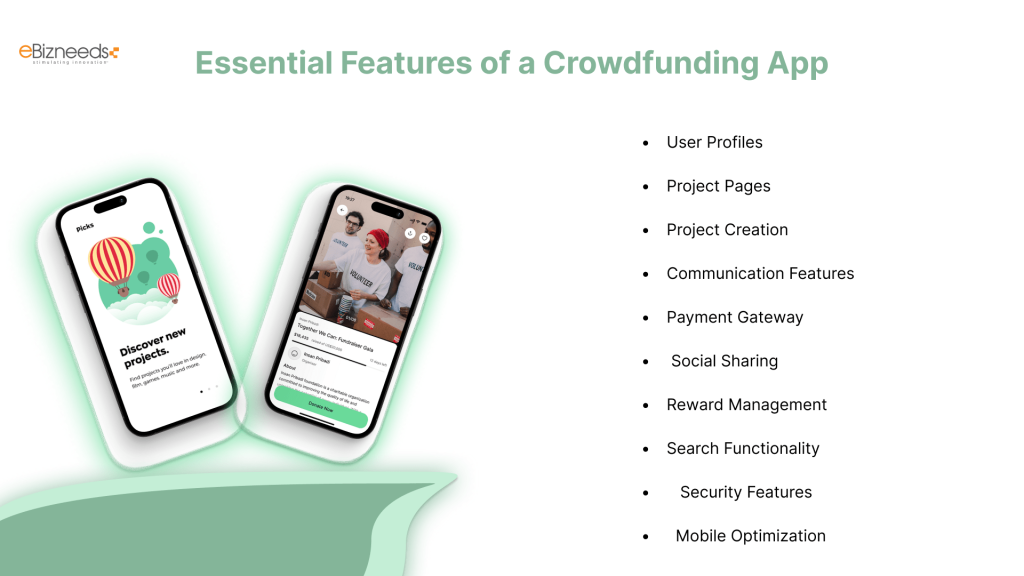


At the initial stage, you should develop a prototype or MVP version of the app. In the MVP version, there are only the essential features within the app.
Once the app gets success for its MVP features, you can roll out the app with a Crowdfunding app.
Here are the major MVP features:
a. User Profiles
The users have to register on the app and create profiles. They have to mention personal information, contribution history, and preferences.
b. Project Pages
In the project pages, the creator should be able to enter every detail like exhibiting the idea, rewards, goals, and funding progress.
c. Project Creation
The users could create and manage projects, including setting goals, timelines, and rewards.
d. Communication Features
The creators should be able to easily with backers, notify them of updates, and address questions.
e. Payment Gateway
A secure payment gateway is required to get contributions from backers quickly.
The social media platform integration will allow us to reach a broader audience.
g. Reward Management
Reward management will allow creators to track and handle the fulfilment of rewards promised to backers.
h. Search Functionality
Users should be able to search projects based on keywords, location, or categories.
i. Security Features
There must be robust security measures to safeguard user data and control fraud.
j. Mobile Optimization
The app should be highly optimized for mobile users and it must be user-friendly.
These are the top features that every crowdfunding app should have. Speaking of which, let’s look at the process to develop a crowdfunding application.
How to develop a Crowdfunding App? The Process
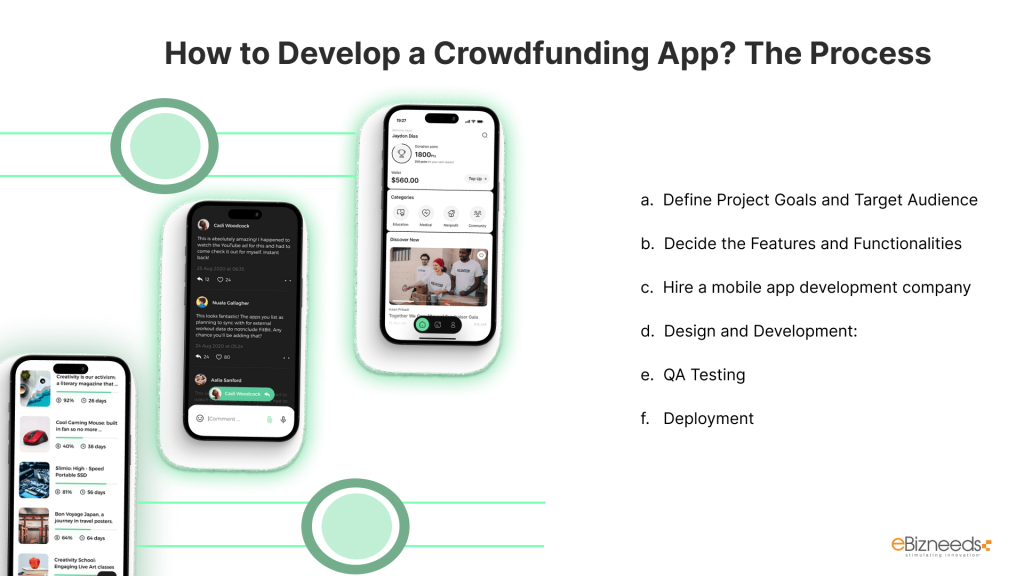


It’s finally time to ask the big question, how do you develop a crowdfunding application?
Well, let’s discuss just that in this section of the blog.
You have to follow below steps to build a successful crowdfunding app:
a. Define Project Goals and Target Audience
The process begins by defining project goals and target audience. You have to analyze the demand for crowdfunding apps within your target audience.
b. Decide the Features and Functionalities
Now you have to identify what features and functionalities are right of your app.
Initially, it would be wiser to go for the MVP features and after getting success, you can roll out advanced features.
c. Hire a mobile app development company
It would always be a wiser decision to hire mobile app developers from a top-notch mobile app development company.
They will help you develop the app from scratch to a fully-fledged working stage.
The mobile app developers should have the relevant experience, skills, and expertise to meet your requirements.
They should have also had reliable feedback from previous clients.
d. Design and Development:
The UI designers must create captivating screens with attractive themes for the app.
The frontend developers will further make these designs responsive and ensure that all the elements of the app work responsively.
The backend developers would be responsible for all the features and functionalities mentioned in the scope of work.
e. QA Testing
After the design phase, the QA engineers have to ensure that there are no bugs remaining on the app.
They have to thoroughly check the app for any persisting issues and ensure the app works smoothly.
The testers also check the app for aspects like performance and security.
f. Deployment
Once the QA team gives the signoff, the development team can deploy the app on the cloud infrastructure and make it live.
This is the development process to create a crowdfunding mobile application starting from market research going all the way to deployment, let’s look at cost.
Cost to Build an Crowdfunding Platform
So, how much does it cost to build a crowdfunding app?
The cost to develop a crowdfunding app depends on various factors, including the app’s complexity, feature set, platform choice (iOS, Android, or web), and the development team’s expertise.
Here’s a breakdown to give you an idea of what goes into the overall fintech app’s development cost:
| Factor | Description | Estimated Cost |
| Platform | iOS, Android, or both. Developing for multiple platforms increases cost. | $10,000 – $20,000 per platform |
| UI/UX Design | High-quality design, user-friendly interfaces, and appealing visuals are essential. | $5,000 – $15,000 |
| Features & Functionality | Basic (MVP) features vs. advanced functionalities like live video streaming or AI. | $20,000 – $50,000+ |
| Backend Development | Building the app’s infrastructure, databases, and APIs. | $10,000 – $30,000 |
| Testing & QA | Ensuring the app is free from bugs, secure, and performs well under heavy usage. | $5,000 – $15,000 |
| Maintenance | Ongoing updates, security patches, and feature improvements. | $5,000+ annually |
Note: These figures are approximate and may vary based on the location of the development team and the specific requirements of your app.
If you’re aiming to launch an MVP version first, expect the costs to be on the lower end.
An MVP includes only essential features, allowing you to validate your concept and gather user feedback before investing in a full-featured version.
Monetization Methods for Crowdfunding Platform
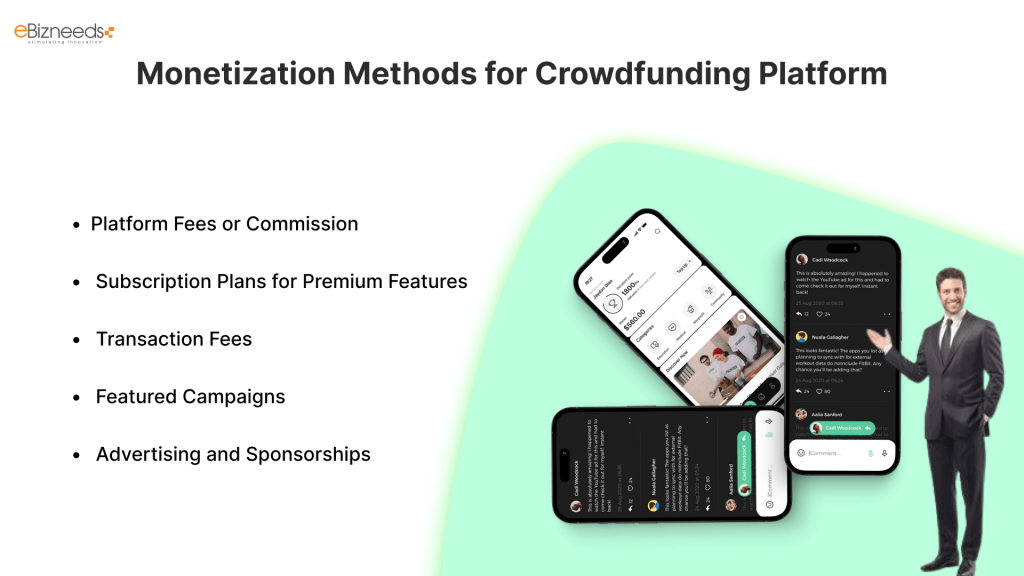


To make your crowdfunding app profitable, it’s crucial to implement effective monetization strategies.
Here are some popular methods used by successful crowdfunding platforms:
1. Platform Fees or Commission
One of the most common ways to monetize a crowdfunding app is by charging a platform fee or commission on the funds raised.
Typically, this fee ranges between 3% and 10% of the total amount raised.
For example, if a campaign raises $10,000, the app takes a cut, and the remaining funds go to the campaign creator.
Offering subscription plans is another way to generate revenue.
You can create different tiers (e.g., Basic, Pro, and Premium) with advanced features available to higher-tier users.
For instance, paid users might get access to detailed analytics, priority support, or enhanced marketing tools that increase their chances of a successful campaign.
3. Transaction Fees
Transaction fees apply each time a contributor makes a payment. These fees can cover payment processing costs or be an additional revenue stream.
For example, you could charge a small fee of around 1-2% per transaction, which adds up over multiple contributions.
4. Featured Campaigns
Some crowdfunding platforms allow project creators to pay for premium placement on the homepage or in search results.
Featured campaigns get more visibility, increasing their chances of reaching a broader audience.
This is especially useful for projects that need quick exposure.
5. Advertising and Sponsorships
If your crowdfunding app gains a substantial user base, you can partner with brands for advertising or sponsorship opportunities.
This may include sponsored campaigns, banner ads, or email promotions to users. Just ensure that ads don’t overwhelm the user experience.



eBizneeds – Your Partner in Crowdfunding App Development
Partnering with a fintech app development company like eBizneeds can elevate your app’s performance. Their expertise in creating secure, user-friendly platforms helps build trust, attracting both campaign creators and backers. Combining strong promotional strategies with expert development support can position your app as a trusted crowdfunding solution.
Wrapping Up
We have gone through all the major aspects of crowdfunding mobile app development. Entrepreneurs, small business owners, investors, venture capitalists, etc. have high utility and aspiration for crowdfunding apps.
FAQs
The development time varies based on the app’s complexity and features. A basic MVP version can take around 3 to 6 months, while a full-featured app may take up to a year. Working with an experienced development team can streamline the process.
Yes, you can develop a crowdfunding app for both iOS and Android platforms. Using cross-platform frameworks like React Native or Flutter can help reduce costs and development time, as you’ll only need one codebase for both platforms.
Some essential features include user profiles, project creation, campaign tracking, payment processing, social sharing, and security measures. An MVP should focus on these core functionalities to validate the app concept.
Security is crucial for a crowdfunding platform due to the sensitive financial data involved. Implementing encryption, secure payment gateways, and fraud prevention measures are essential steps. Regular security audits and updates also ensure the app remains safe for users.
Maintenance costs depend on the app’s scale and complexity. Generally, you should budget around 15-20% of the initial development cost for annual maintenance. This includes updates, security patches, and server management.



Naveen Khanna is the CEO of eBizneeds, a company renowned for its bespoke web and mobile app development. By delivering high-end modern solutions all over the globe, Naveen takes pleasure in sharing his rich experiences and views on emerging technological trends. He has worked in many domains, from education, entertainment, banking, manufacturing, healthcare, and real estate, sharing rich experience in delivering innovative solutions.
